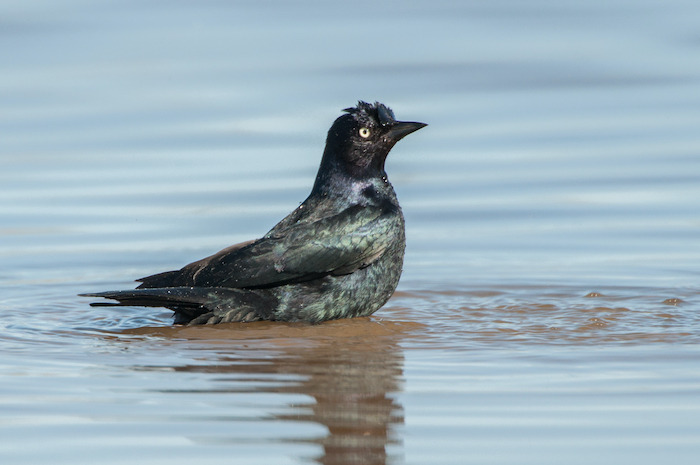
We mostly see blackbirds in suburban settings, but they are not limited to our neighborhoods. Blackbirds now returning to local parks and parking lots may have just finished a nesting season in the sagebrush of the Great Basin or in marshy alpine meadows. But even when they’re here, it’s easy to overlook them. They seem a common and ordinary part of the background, too plain to attract attention.
But the blackbird tribe is varied and beautiful. Male red-winged blackbirds strike the eye with their bright scarlet wing patches. Starlings, the stumpy-tailed birds in the group, shed their shiny black feathers for new winter plumage, a gala coat of black and brown speckles. Brewer’s blackbirds look slightly more elegant–no speckles, and they stand more erect and seem more considerate in their movements.
Brewer’s blackbirds might be a soft brown, tip to tail. Those are the females, matte-finished for camouflaged child-rearing. Others might peer at you with a golden eye from glossy black feathers that gleam in sunlight with a purple and green wash. Those are the ones you’ll notice, the males, designed by nature to catch the eye and perhaps draw predators. It is the males’ hapless duty to guard the nest while the females incubate their young.
Blackbirds nest in colonies. The first females to settle into nesting set the trend, choosing almost any sort of habitat, but mostly in brush or trees near water. Other females select nearby sites to build their nests; they all incubate their eggs for about two weeks. More like raptors than songbirds, sometimes Brewer’s blackbirds begin incubating before all the eggs are laid. This results in eggs hatching over several days instead of all at once, a condition that typically favors the eldest nestlings if food gets scarce.
During incubation, the males chase predators from the vicinity and may bring food to their mates on the nest. Once their young hatch, blind and naked, males and females together feed them insects along with some seeds and fruit, until the nestlings fledge and can feed themselves.
In winter, mated pairs may separate into the huge flocks that blackbirds often form for foraging and roosting. But most will rejoin their partners for the following nesting season.
The ability of blackbirds to live in a wide variety of habitats–arid scrubland, high mountain meadows, cattails, golf courses, city parks–usually bodes well for species to thrive through changes. It is not surprising that blackbirds are among our most numerous songbirds.
Still, they have not been able to escape the world’s massive declines in habitat. In 1966 the global number of Brewer’s blackbirds was estimated at nearly seventy million, three and a half times California’s human population at the time. Now the blackbirds, down to about twenty million, number just half our increased state population.
